By David H. Lippman
From Leningrad to Murmansk, columns of Soviet Red Army troops stormed down roads and trails into Finland’s dense forests, lakes, and swamps, seeking to cut Finland in half.
Soviet Union Communist Party General Secretary Josef Stalin—known simply as the “Vozhd” or “Boss” to his inner circle—had ordered his massive armies to invade Finland, a blatant act of aggression, in 1939, a year of aggression. His massive armies, lavishly equipped with tanks, guns, and aircraft, easily outnumbered the Finns, and Stalin expected that he would carve out a land barrier between Leningrad, Russia’s “Window on the West,” and his supposed ally, Nazi Germany.
At first the bloodthirsty dictator sought to gain millions of acres of Finnish soil through diplomacy, but despite their country’s small size and weaker economy the Finns were tougher than the nations that had given in to Hitler in 1938 over Czechoslovakia. They would not yield an inch of their forested soil. Their three million people would stand against the Soviet Union’s 105 million.
On paper, the Finns had no chance. But this war, like all wars, was not fought in a ledger book. Unlike other wars, the war between Russia and Finland was fought in a winter landscape of endless forests, swamps, frozen lakes, subfreezing temperatures, and wilderness. Unlike their enemies, the Finns were at home in this dreadful environment and prepared to fight in it.
Stalin had gutted his army during bloody 1930s purges, turning the once formidable machine that had defeated the White Russian Army and Western invaders in the 1920s into a corps of obedient and incompetent lackeys. Despite the harshness of Soviet winters, Russian troops were not trained or equipped for winter fighting. Soviet field kitchens, for example, spewed out easily seen black smoke through chimneys that went straight up. Finnish kitchens used screens to hold back dark ash and vented horizontally.
Skiing was Finland’s national pastime, and the Soviets ignored it. As a result, Soviet ski troops were trained to stand upright and fire their rifles from their skis. Finnish troops were trained to fire their rifles prone, using the skis as braces for their rifles to ensure accuracy. Invading Soviet forces did not bother to wear snowsuits and were slowed by heavy vehicles that could not operate offroad in the heavy snowfalls.
The Finns had another edge, their supreme commander, Baron Carl Gustav Mannerheim, age 72, a former czarist Russian Guards officer, hero of the Finnish Civil War, big-game hunter, humanitarian, and national icon. He insisted that Finland refuse to negotiate. When Finnish politicians sent a delegation to Moscow to talk peace, he resigned his position as commander in chief. Just before the war broke out, the Finnish government begged him to resume his position and he did so. A Spartan, cold man, he dominated any gathering by the sheer force of his imperial personality. Perhaps most importantly, the Finnish Army and its men were trained to use their own initiative in difficult situations, counterattack swiftly, and were above all free men fighting for their homes against a foreign invader. The Soviets were that invader, and their initiative and flexibility had been sapped by the purges and political officers that peered over every commander’s shoulder and reviewed his plans.
The Soviet attack came on a wide front. On November 29, 1939, the Soviet 155th Infantry Division attacked the Finnish 4th Corps in the Suojärvi sector, headed for a key road junction at Ilomantsi in Finland’s midsection. Some 40 miles to the south, the 139th Infantry Division attacked through lakes along the axis of the Tolvajärvi Road, headed for a major road, which would in turn enable the Soviets to cut the rail line that supplied the entire IV Corps, imperil that force, and prevent its own counterattack. If the Soviet attack succeeded, it could cut Finland in two.
To add punch to this offensive, the Soviet 55th Infantry Division was moving parallel to the rail line between Suojärvi and Loimola. Lastly, the 168th Infantry Division, moving on the shore road, was headed northwest to Kitelä. The Soviets advanced slowly, bogged down by the tractors they were using to haul supplies and artillery.
Studying his maps and the panicked reports from IV Corps officers, Mannerheim turned to an ad hoc force named Task Force R after its commanding officer, Lt. Col. Veikko Räsänen, which consisted of four independent infantry battalions and PPP-7, the designation for the 7th Bicycle Battalion. PPP-7 had left its bikes in the barracks and was operating on skis, like everybody else in the Finnish Army. The task force was weak in artillery with only five or six modern guns in the rear and two 50-year-old field pieces on the border.
The troops were tough enough, but Räsänen did not rise to the occasion—he seemed shocked and quickly lost his grip on the situation. At a time when frontline leadership was desperately needed, Räsänen stayed in his bunker at Ägläjärvi, six miles behind the front—too far for the Finns with their erratic communications.
When the Soviets hit the Finns on November 30, they streamed across the border but showed considerable caution—every time a Finnish rifle opened fire, they hit the ground. One Finnish automatic rifle team held up a full Soviet regiment for more than an hour near Jehkila at the northeast tip of Lake Suojärvi.
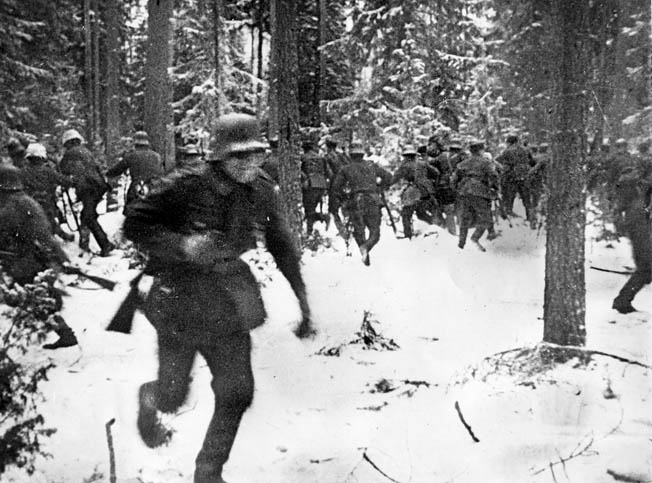
But on December 1, the weight of Soviet numbers began forcing the Finns back. They set up delaying positions at Varpakyla. The Soviets attacked with frontal assaults over open terrain and fell in heaps. But the sacrifice diverted the Finns from efforts to flank the defenders’ roadblocks, forcing them to retreat to further delaying positions.
To buy time, Finnish engineers blew a dam on Lake Suojärvi’s western shore, which flooded icy water over both sides. The Finns took advantage of the flood to flee, but the water soon froze up and the Soviets resumed the attack, driving the Finns off a north-south road from Suojärvi and Salonjärvi and its roadblock.
Task Force R dug in on the western bank of the Aittojoki River, with PPP-7 as the reserve at Ägläjärvi. Among the Finnish troops digging in was Special Battalion No. 112, made up of rear-echelon paperchasers with very little training and outdated equipment.
The Soviet advance was worrying Mannerheim, and he personally ordered Task Force R to counterattack on December 3 to reopen the road. The Finns jumped off on time and surprised the Soviet invaders. But when Soviet tanks showed up, the Finnish attack was stalled in its tracks.
Soviet troops and tanks began moving across Lake Salonjärvi’s ice to encircle Task Force R. The only unit left to save the day was Special Battalion No. 112, and they charged into a counterattack, hurtling the Soviets into the forest. The assault gave the Finns time to withdraw to the prepared defenses on the Aittojoki.
The next morning, December 4, the Soviets attacked the Finns in the misty predawn darkness. The Finns held the line for three hours against heavy frontal attacks.
Finally, the Soviets broke through and slammed into PPP-7’s headquarters. The battalion’s commander, a major, rallied his miscellaneous collection of clerks, medics, cooks, quartermaster troops, and walking wounded, who fought the Soviets with personal sidearms, knives, and weapons grabbed from the dead. The Finns put up a determined fight, but halfway through the battle the major was wounded and rumors spread that he had been killed. The defenders collapsed in fear and panic. The men at the front, learning that their rear was being torn apart, also caved in. Räsänen and his headquarters team had to flee to Tolvajärvi while the rest of Task Force R fled to Ägläjärvi.
By morning on December 5, Task Force R had regrouped and dug in. Mannerheim ordered Räsänen to counterattack, and the colonel formulated a risky and ambitious plan—PPP-7 would go forward, braced on the flanks and rear by Special Battalion 112. These two outfits would absorb the next Soviet attack and hold it in place while the rest of Task Force R, in the dense forests north of the road, hit the Soviet flank.
The plan would have been a good one if the Finns had good communications and more men, but they did not. PPP-7 broke under Soviet pressure in the first quarter hour on December 5. The rest of Task Force R never got the word to make the flanking attack, which would have easily cut off the Soviet advance.
Räsänen ordered another retirement, but this was conducted in good order thanks to the energetic Special Battalion 112. The Finns were now a group of hungry, scared, exhausted, frozen, depressed, whipped men falling back on Tolvajärvi and its hills and frozen lakes. Räsänen gloomily reported to Mannerheim that his men were nearing the point of ineffectiveness.
Finnish troops had retreated more than 40 miles and showed the strain. Some men had shot at each other by mistake, and others had fled at the mere rumor of tanks. Now the Soviets were poised to take the rail junction at Värtsilä. If the Soviets did so, they would collapse the Ladoga-Karelia front, and the Mannerheim Line would be open to attack from the rear.
The situation was desperate for Mannerheim. Studying his maps, he ordered JR-25 of the 9th Division to entrain for Kuhmo to serve as the nucleus of a newly formed brigade, despite its shortages of clothing and equipment. JR-27 was sent to Suomussalmi on December 7. The third and last regiment of the 9th Division, JR-26, was left on the Karelian Isthmus, facing the biggest Soviet offensive.
On December 5, JR-16 of the 6th Division was assigned to Mannerheim’s personal command and sent to Tolvajärvi to stiffen the defenses.
The Finns continued to crumble on December 5. Ägläjärvi fell, putting them halfway between the border and the rail junction. The Soviet 155th Division was storming toward Ilomantsi, which would mean that all the Finnish troops at Tolvajärvi would be cut off.
The only good news for Mannerheim was that the Soviet attacks north of Lake Ladoga were not coordinated; they were separate columns attacking up roads and trails, tied by their heavy vehicles to those narrow arteries, unable to properly deploy beyond them or move and fight well in the adjoining woods, swamps, and frozen lakes.
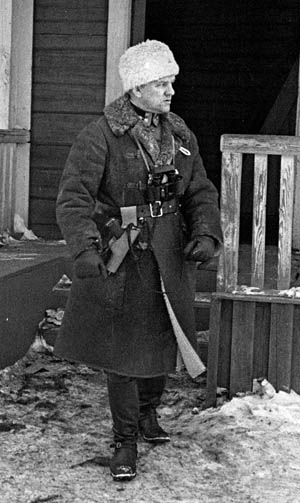
Mannerheim realized that if these isolated columns could be cut off and destroyed quickly the Finnish troops fighting there could be transferred to the Karelian Isthmus to hold the main front on the Mannerheim Line. All that was needed was some determined leadership.
Fortunately, Finland abounded in such men. Mannerheim appointed one of his best officers, Maj. Gen. Woldemar Hägglund, as commander of the IV Corps and assigned him to defeat 10 Soviet divisions.
Next, Mannerheim turned to a close personal friend, Colonel Paavo Talvela, a hero of the 1918 civil war, vice president of the national film company, and president of the state liquor board, to serve as field commander. Talvela was an appropriate choice. He had completed extensive map wargames over that area while studying at the Finnish War College, where he had graduated at the top of his class. Bold, resolute, tough, Talvela was an imaginative tactician and familiar with the terrain. Mannerheim described him as “a fearless and strong-willed commander, who possesses that degree of ruthlessness required in an offensive against a greatly superior adversary.”
Mannerheim sent JR-16 from Oulu to Värtsilä late on December 5, and Talvela arrived at Mannerheim’s headquarters at 4 am on December 6, Finland’s Independence Day, wearing full dress uniform.
Mannerheim briefed Talvela on the situation. The Soviet attack was two campaigns, one on IV Corps’ northern flank, along the road from Suvilahti to Kollaa, and another on the roads to Tolvajärvi and Ilomantsi. Mannerheim would therefore detach all the troops on the latter front from IV Corps to report directly to him. This force would be under Talvela and called Group Talvela.
Talvela’s job was to halt the enemy drives, throw them back, and recapture Suojärvi’s road network, cutting off all supplies to the southern Russian column on the Kollaa Road. Talvela would have less than half the manpower of his opponents, no armor whatsoever, no air support, and precious few mortars and artillery.
Still, Talvela was eager to take the offensive. JR-16 would be his trump card. It was commanded by an old friend and Finnish Civil War comrade, Lt. Col. Aaro Pajari, a highly competent officer who concealed his heart condition beneath great determination. Talvela phoned Pajari and told him to find out what was going on at the front and then drive back to Värtsilä with a full report. Pajari did so, talking to commanders and frontline soldiers, urging them to speak freely. He spent some time studying terrain and fresh intelligence reports and then headed back, meeting with Talvela at 3 am.
Pajari’s report was grim. The defenders of Tolvajärvi had been retreating for a week, pounded by artillery and tanks, only able to respond with machine guns and hand grenades. The men were physically exhausted, edgy, and discipline was being maintained only by a thread. One more Soviet push would break them. The opposing Soviet 139th Infantry Division had a high level of training and tactical cohesion and was making solid flanking attacks. The Finns were on the wrong end of five-to-one numbers.
To make matters worse, the weather was aiding the invaders. Snowfall had been light and spotty, meaning that the offroad snowdrifts were not enough to hamper Soviet troops and not enough to provide Finnish ski troops with their advantages. Pajari concluded that the Finns needed something close to a miracle to halt the Soviets. Taking the initiative was simply impossible.
Talvela absorbed this report and had another worry, the secondary threat at Ilomantsi. There the Soviet 155th Infantry Division was heading southwest and nearly 10 miles from the town. Against this the Finns could put up only two battalions, but the Soviet drive was really being stopped by the 155th Division’s commander, General Gusevski, who was moving cautiously.
Talvela decided to gamble. Assuming that the 155th would continue to move slowly, he would focus his strength on Tolvajärvi. First, he would put steel in the Finnish defenses. The Finns would hold the west shore of Lake Tolvajärvi. Talvela sent Pajari back to the front, no longer as an observer, but as commander. He would relieve the hapless Räsänen. Talvela said later, “In situations like this, as in all confused and hopeless situations, an energetic attack against the nearest enemy was and is the only way to improve the spirits of the men and to get control of the situation.”
But while the two officers planned their strategy, the fighting went on. PPP-7 retreated five miles from its position at Ristisalmi on the eastern shore of Lake Ala Tolvajärvi to Lake Hirvasjärvi, north of Lake Tolvajärvi.
However, Talvela got some help from IV Corps—a battery of artillery on December 6, two more en route, and an independent battalion, ErP-9 (“Er” standing for “independent” or “detached”). Pajari’s own regiment, JR-16, reached the front on December 7.
The 1st/JR-16 arrived first, early on December 7, and began digging in west and north of a bridge that spanned the narrows between Lakes Tolvajärvi and Hirvasjärvi. But as soon as the battalion began digging in, it came under enemy artillery fire, and some of the Finns fled as far west as Korpiselka. That opened a gap in the Finnish lines that enabled the Soviets to gain control of Kottisaari and a long narrow peninsula called Hirvasharju, which extended to the northwest and split Lake Hirvasjärvi from Lake Tolvajärvi. On that peninsula stood a new two-story tourist hotel, built chalet-style with the second floor overhanging the first. It had a superb view of the lakes and hills. The commander of the Soviet 609th Infantry Regiment saw it as a command post and bunker and turned it into his headquarters.
Talvela arrived on the scene late in the day to find 1st/JR-16 retreating and reorganizing and tried to rally some of the men. They were too dispersed for him to do so, but the panic had run its course. The weary men regrouped, and 3rd/JR-16, under Pajari, arrived. Pajari ordered his men to dig in, walking up and down the line, calmly and firmly telling his men to do their duty. Despite his calm voice, Pajari had misgivings.
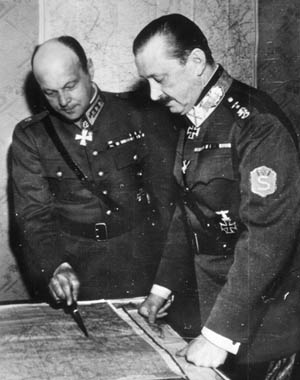
Pajari’s force was badly equipped by Finnish standards, lacking uniforms and snow boots and as unprepared to face the sub-zero temperatures as it was Soviet artillery fire. Fortunately, 3rd/JR-16 was not hard pressed. The Soviets were consolidating positions around the hotel that Pajari could see through his binoculars.
Early that evening Talvela conferred with Pajari, and they agreed that the situation had stabilized but the virus of defeat was spreading. Dramatic action was needed to curb the panic, regain the initiative, and show the Finns that the Soviets could be beaten.
Talvela sketched out a broad scheme for a strong raid against enemy troops, going across the frozen Lake Tolvajärvi and hitting the Soviet troops bivouacked on the road to Ägläjärvi. Talvela wanted to lead the raid himself, but his staff talked him out of it. Pajari, despite having had a tough, long day, volunteered to lead the raid.
The raiders were drawn from 2nd/JR-16, which had not been engaged yet. Just before midnight, two companies—the 9th and 4th—moved across the ice south of Kottisaari Island. An hour later, PPP-7, under its new commander, Major Ericsson, launched a feint against Kottisaari itself. The diversion did not fare too well. Ericsson was killed early—the second PPP-7 battalion commander lost in five days—and the battalion withdrew.
But 2nd/JR-16 moved across the ice beneath a moonless and empty sky, the only sound the scrape of its skis and the occasional whisper and crackle of ice responding to pressure. For all the Finnish troops, the move was terrifying —the utter darkness, the cold, the fear that a Soviet patrol might spot them at any minute. Logically, under these conditions the two companies got lost. The 9th Company hit a patch of open water, headed south to avoid it, and lost touch with 4th Company. Eventually, the 9th crossed the lake but met some Russian pockets, which led to a firefight in the dark.
But 4th Company held to its route, headed by Lieutenant Urho Isotalo and Pajari. An hour after crossing the lake, Finnish scouts saw large bonfires in a gully near the Kivisalmi Bridge. The Finns had met up with a small Russian security patrol and killed the lot soundlessly.
Beyond that stood a long, low, heavily timbered ridge, and farther beyond was more firelight. The raiders fanned out at the base of the ridge and advanced up it simultaneously so that the entire force would reach the crest at the same time. When Pajari crawled the last few meters to the top, he whipped out his binoculars to peer through the evergreens. He saw a vast encampment 100 meters away, holding a full Soviet battalion, all asleep or keeping warm at their campfires, and no sentries posted. In the distance, Pajari saw two more encampments for two more battalions. Pajari’s one company was about to ambush an entire Soviet regiment.
While the Soviets continued to doze, Pajari moved his men into position. They heard PPP-7 making its diversion in the distance, but the Soviets before them were uninterested as a few men looked up at the sound, shrugged, and returned to their fires.
By 2 am, 140 riflemen and 16 automatic weapons were posted in a semicircle along the ridge crest concealed in bushes, snow, and brush. All the men had targets acquired. Talvela fired the first shot himself, and the Finns opened up with everything they had into the gully beneath them.
The Soviets were so shocked by the force and violence of the Finnish ambush that they did not fire back. In three to four minutes, there were no standing targets—only heaps of dead Soviet soldiers lying in rings around their still blazing fires.
The Soviet battalions in the distance reacted to the noise and destruction by opening fire in all directions. Pajari led his men out through a gully near one of the encampments to confuse pursuers. The Finns slithered away while the Soviets waged a fierce firefight with each other that went on for two hours.
Pajari and his men found the return march more tiring than the approach. Pajari himself, suffering from a heart condition, needed to be transported in an improvised litter. But everyone made it back, some with badly needed Soviet felt boots, and the victory was complete.
Finnish morale was boosted by the feat. It was the first large-scale victory on the IV Corps front. More importantly, the raid knocked the Soviets off balance. They made no further major attacks in the area for two days, limiting themselves to patrols, artillery duels, and sniping.
With Tolvajärvi in hand, Talvela went up to Ilomantsi, where the Soviet 155th Infantry Division was still plodding along slowly, only 12 miles from the Ilomantsi-Korpiselka road junction. The Finnish ErP-11, under Major Nikoskelainen, was trying to stop the Soviets at the Möhkö Hill. Talvela ordered the heights held at all costs, and his troops did so until being forced to pull back to Oinaansalmi on December 9.
Talvela put all Finnish troops in the Ilomantsi sector under Colonel Per Ekholm and named the command Task Force E. This consisted of four infantry battalions, but two of them were poorly trained ex-quartermaster troops. On December 8, the Ilomantsi defenders were reinforced by a battery of mortars, and a day and a half later by two old French 75mm field pieces, one of which proved inoperable. Task Force E already had five antique light field guns. This force would face the fully equipped Soviet 155th Infantry Division.
However, Ekholm proved ferocious. One of his patrols found an understrength Soviet battalion of 350 men wandering behind the Finnish left flank about five miles northeast of Ilomantsi, in a bog named Tetrilampi. Ekholm ordered the Soviets attacked by a strike force equipped with automatic weapons, and the Finnish group quickly surrounded the Soviets. During the night, Ekholm set up an ambush. At dawn the Finns opened a murderous crossfire on the Soviets. Not one Russian survived.
The 155th’s commander, baffled at the disappearance of an entire infantry battalion, became even more cautious.
Talvela was impressed. His men were not just holding ground; they were taking action, throwing the Soviets off balance, and building up their own morale. It was time to attack on both fronts. He finished his plans on December 10 and ordered the attack to go in the next day.
Before Talvela could attack, the Soviets hit him on his left flank, using the ski battalion of the Finnish National Army, a collection of renegade Finns who were willing to fight for Stalin. The entire battalion marched through the forests on his left flank at Lake Tolvajärvi. The Soviets aimed at Talvela’s supply line, the road to Korpiselka. There were no defensive works there, just field kitchens, artillerymen, quartermasters, and the headquarters company. At 11 that night, the Soviets attacked the position, where Finnish cooks were simmering large vats of sausage soup. The Soviets scattered the panic-stricken cooks and then sat down to eat the Finnish soup.
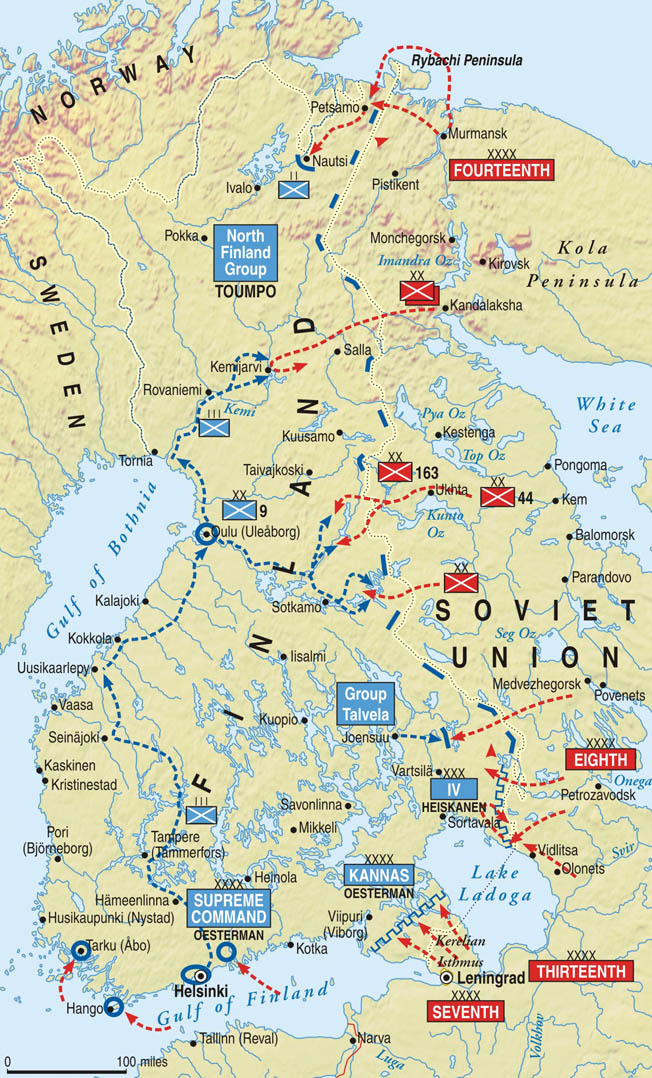
While they did, the Finns had a little time to recover. It was a stroke of luck for the Finns. Another was that Pajari himself was nearby. On his own initiative, he assembled 100 cooks, clerks, medics, supply sergeants, and artillerymen, and led them in a counterattack. It was a rare example of bayonet fighting in the Russo-Finnish War, and the Finnish troops, furious to see their own countrymen fighting for the hated Soviet invader, took no prisoners.
Meanwhile, Pajari summoned two companies of frontline troops to back up his ragtag band, and they hit the renegades from the east. By 4 am, the Finnish National Army was in full retreat, and by dawn the fighting was over. Only a few of the renegade Finns made it back to their lines. The road and forests were strewn with frozen corpses, at least 100 of them near the bullet-riddled soup pots, some with hunks of sausage still clinging to their gray lips.
The battle became legendary in Finnish history as the Sausage War and was a major boost to Finnish morale.
But the Tolvajärvi struggle continued. The same night, a Russian battalion moved out from Kottisaaari Island across the ice, heading for Tolvajärvi village from the south.
The Finns were alert, and Lieutenant Eero Kivela’s JR-16 company was first to get hit. He left two platoons and his heavy machine guns to hold the village and outflanked the outflankers with three rifle platoons. At dawn, the Soviets were just across the lake, still in the open. Kivela’s men wasted no time. They opened fire and killed scores of men with their first volley. The Soviets panicked and fled across the open ice, making superb targets. Kivela’s men kept firing until the Soviets were gone and then strode onto the ice to seize 16 machine guns from the dead men before retiring.
The Soviets kept trying on December 11, but the other attacks were less threatening. One Soviet objective had been achieved, perhaps unintentionally. Talvela would have to postpone his own counterattack until December 12.
Talvela assigned the task to the freshest men he had, Battalion ErP-9 and two companies of 1st/JR-16. If they could open the Russian defenses, his other forces could go through the hole in the lock. One pincer would cross the northern end of Lake Hirvasjärvi, pivot southeast, and hit the Hirvasharju Peninsula from the high ground in the rear, striking the tourist hotel, which was the lynchpin of the Soviet defenses.
When the northern pincer had made progress, Pajari would lead a frontal assault on the peninsula. Pajari would have his own troops along with a company from JR-37 and the 10th Independent Battalion (ErP-10). A third southern pincer, consisting of two companies of ErP-112, would assault Kottisaari Island, taking its high ground and enabling Finnish guns to interdict the Soviet supply line —the road over the Kivisalmi bridge. With luck, good timing, and determination, the Finns could win.
Talvela also made plans to counterattack at Ilomantsi. On December 11, the Soviets attacked at Oinaansalmi and the ferry crossing at Kallioniemi. In both places, the Soviets were thrown back with moderate casualties—two tanks wrecked by satchel charges and Molotov cocktails at the former and 134 dead at the latter. Now Talvela wanted three of Ekholm’s battalions to hit the Russians at Möhkö from the flanks and frontally.
On the other side, Commander Belaev, who headed the Soviet 139th Division, was under pressure to advance. Corps Commander Panin arrived at the 139th’s tactical headquarters on the morning of December 12 and personally took command of the division, ordering Belaev to attack.
The Finnish attack went wrong from the start. The 2nd and 3rd Companies of JR-16 moved off on the northern pincer at Lake Hirvasjärvi in foot-deep snowdrifts, unable to reach their start lines until well after daylight, costing them tactical surprise. While these Finns tried to sneak up on the Soviets, the Soviets were trying to do the same in accordance with Panin’s orders.
Instead, both sides surprised each other. The 3rd Company, on the far Finnish left, took the heat of the attack and Soviet machine-gun fire, and the Finns withdrew all the way to the Tolvajärvi Road. The 2nd Company slipped past the Soviets across the lake and readied for the southward turn when it was stopped cold by heavy Soviet fire at 11 am. Pinned down, it lost contact with ErP-9.
That battalion was not doing much better. One company got mangled in the battle and retreated to the Tolvajärvi Road by 10:30. The battalion regrouped and joined the 2nd Company to prevent them from being overwhelmed, but this Finnish group could make no progress and withdrew, except a group of 100 men from the 2nd Company, which stayed in the battle, drawing down large numbers of Soviet troops.
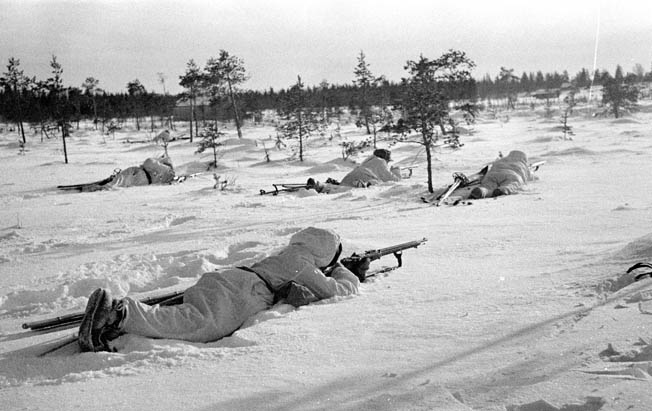
The southern pincer did not do too well, either. ErP-112 attacked at 8 am backed by heavy machine guns and four or five artillery pieces. The men crossed the frozen lake, clambered up the island, and reached some rocky islets near the Kivisalmi Bridge, but their support, the 9th Company of JR-16, never showed up. Their regimental headquarters never gave the company commander a jump-off time, so by the time he was told to advance it was long past the designated hour. He had to wait for further instructions.
The third thrust, in the center, was assigned to 2nd/JR-16. Pajari did not want to send his men against fortified positions over open ground without artillery support, and the guns did not get into position until two hours after they were supposed to. When the Finnish shells came crashing down, there were so few that Pajari cursed himself for waiting in the first place.
Pajari gave the word, and Lieutenant Isotalo led his 2nd Company of JR-16 across the straits on the lake’s southern side with machine guns providing cover fire. Suffering only light casualties, 2nd Company moved across. However, 6th Company came under Soviet artillery and light automatic weapons fire, which tied them down. Soon the 4th, 5th, and 6th Companies, all intermingled, were pinned down as well.
Yet the Finns continued to attack. Backed by their machine guns, the ski-suited Finns silenced Soviet troops in their foxholes and gun pits and began engaging the Soviet heavy machine guns.
Incredibly, the Finns fought their way forward to the tourist hotel. Soviet troops in the fortified hotel opened up with gunfire from windows and loopholes cut into its thick log walls. Finnish officers showed considerable initiative, grouping and regrouping miscellaneous troops into combat teams to fight for the village and hotel. Officers and NCOs took casualties. Lieutenant Isotalo was shot in the hand, paused to get it bandaged, and then went forward to lead his men again.
The hardest fighting took place in a line of gravel pits about 200 yards west of the hotel and its hill. The road was narrow, the terrain jagged, and the Finns had to advance in single file. Pajari had his 37mm Bofors guns sited just in case—and soon enough three Soviet tanks trundled up the road to counterattack. The Bofors guns opened fire, and the three tanks were destroyed.
Pajari decided that there was still just enough of a fight on his northern flank to divert the enemy and enable him to reinforce the men in the gravel pits across the frozen lake. He ordered 3rd Company of ErP-10 to do so, and the 2nd Company of ErP-10 to attack straight across Lake Myllyjärvi into the base of the Hirvasharju Peninsula’s wishbone shape to put pressure on the hotel from the northwest.
The attack resumed at 1:30 pm. Finnish troops, refreshed by food and cigarettes, charged up a 60-foot hill against the chalet-style hotel and its log and granite walls. Soviet troops in the building and rifle pits in front of it blazed away with machine guns, rifles, and grenades. If the Finns had been supported by artillery, they could have easily taken the hotel, but instead the struggle came down to a battle of infantrymen.
The battle raged back and forth for an hour, hand to hand at some places. Finnish troops hurled grenades through hotel windows and shoved bayonets into Soviet bodies. Soviet troops counterattacked. One Finnish company commander was killed, another gravely wounded.
The scale was tipped when the 2nd Company of ErP-10 arrived, bringing the hotel under fire from the north, weakening the Soviets. Some Finns were able to sneak around to the building’s southern side and snipe at its windows, which made the Soviets realize they were close to being surrounded.
Some of the defenders began to withdraw to the Kivisalmi Bridge, and the Finns, sensing victory, launched a charge into the hotel, hurling dozens of grenades through the ground floor windows, silencing all resistance on that floor.
However, there were still Soviets on the upper floor, and they maintained a heavy fire. As long as they held the hotel, the Finns could not advance. Lieutenant Siukosaari, commanding 6th Company, figured that the best way to eliminate the problem was to pour gasoline into the building, set it ablaze, and shoot any Soviets who tried to flee. A major standing nearby overruled that thought and ordered a more conventional assault. The decision may have been due to squeamishness or because the hotel was a prominent source of local pride.
Either way, Siukosaari led the attack by example, brandishing his Lahti pistol. He ran smack into a Russian officer armed with his own pistol at the doorway leading to the hotel kitchen. Both men opened fire three feet apart, but Siukosaari’s shot hit first, killing the Soviet. Siukosaari’s men charged over the dead Russian into the hotel.
The Finns then had an easier time, hurling grenades into the upper level and then rushing up the stairway. They found 28 Soviet soldiers still alive, most of them wounded and ready to surrender, along with the corpse of the commander of the 609th Soviet Infantry Regiment and the usual regimental papers, all valuable for intelligence. Of greater value to Siukosaari and his crew were the 18 usable automatic weapons and ammunition—they doubled his platoon’s firepower.
Buoyed by the victory, Pajari threw in the last card in his deck, Bicycle Battalion PPP-7, which mopped up as far as Kivisalmi Bridge. Pajari had won the southern part of his battle.
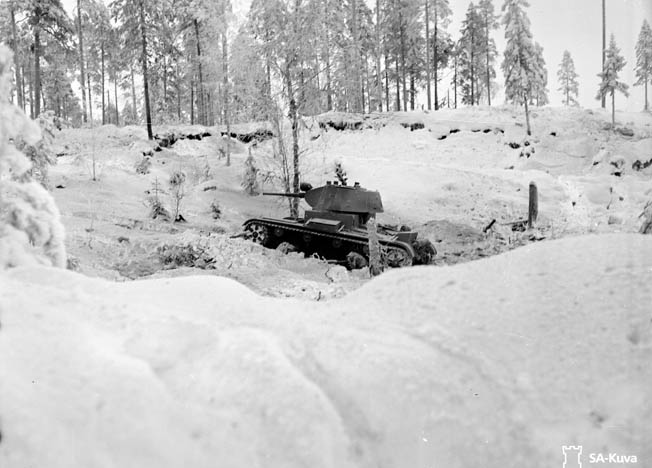
At Ilomantsi, the uneven struggle went on all day. The double pincers at Möhkö did not accomplish much, but near Kallioniemi the Finns knocked out four more tanks.
The next day, the Soviets made more infantry probes at Kallioniemi and the Finns tried again at Möhkö. By day’s end, the Ilomantsi front was a stalemate. The Finns lacked the power to throw the Soviets back, and the Soviet 155th Infantry Division lacked the skis—and therefore the mobility—to flank the Finns. The temperature dropped to 25 degrees below zero, and the endlessly falling snow was more than a foot deep. The Soviets could not budge the Finns.
However, the Finns had skis and the training to use them, and Ekholm waged an active defense, staging raids and probing attacks against the 155th Infantry. As December dragged on, the Soviets tried to defeat Ekholm with little success. At one point, they slipped a battalion through Finnish lines and menaced his headquarters. Ekholm rallied his rear-echelon troops, counterattacked vigorously, and drove the Soviets off. The area remained quiet for most of the war.
Not so at Tolvajärvi, where PPP-7 began moving forward to Ristisalmi on December 13, while the rest of Pajari’s troops took a day off to reorganize. Pajari was not happy with that. He recognized that the best way to deal with the opposing Soviet 139th Infantry Division, as any other Soviet unit, was to attack relentlessly. After the 13th, Pajari drove his men to do just that.
Meanwhile, the Soviets were determined not to give up at Tolvajärvi. They reinforced the battered 139th Division with the 75th Infantry Division. Pajari learned of this development on December 16 as Finnish air reconnaissance saw exhausted and wounded men of the 139th heading back to Russia while vehicles and men of the 75th headed forward.
Pajari moved swiftly. He continued his attack on December 14, with ErP-9 leading the assault. The Finns were stopped when two Russian tanks appeared, driving back and forth, hurling shells and machine-gun fire at the Finns, who could fire back nothing but colorful invective. They did not even have Molotov cocktails. When word of this holdup reached ErP-9’s headquarters and its sole antitank gun crew, one of its gunners, Corporal Mutka, hitched up the 37mm gun to a farm horse, mounted it, and rode the horse bareback to the front. Once there, Mutka unlimbered the gun, aimed at the tanks, and blasted them open with three or four shots.
When the Soviet tanks exploded into the usual balls of fire and smoke, the infantry they were operating with were demoralized and began to flee. The Finnish troops charged forward a mile before being stopped at Metsanvaara Ridge.
Talvela sent Pajari 350 replacements on December 15, all overage reservists. They were ready to fight but poorly trained, poorly armed, and not as physically resilient as the young men who had died or were wounded.
Pajari ordered his men forward, and on December 16 they pushed past Metsanvaara and made good progress until hitting a determined group of Soviet troops at a roadblock just west of Lake Hietajärvi. The defenders were 200 men from a Russian officer candidate school, well trained, physically fit, highly motivated, and properly dug in. The Finns who fought in this battle later said they were the toughest troops they faced. The officer candidates inflicted heavy casualties on the attacking Finns. The 6th Company of ErP-9 lost six of 20, including its commanding officer, in the first hour of fighting. The officer candidates fought to the death. Only two are known to have survived.
Pajari could not afford such engagements and their attendant losses. He tried to outflank the main road, relying on skis and surprise. He sent an ErP-10 company on a wide end run to the south through Vieksinki and launched guerrilla strikes on the Ägläjärvi Road. Two companies of ErP-10 did the same from the north.
Seeing that Pajari was making great gains, Talvela gave him control of all Finnish reserves in the Tolvajärvi sector on December 17, with an order of the day that read: “The last energies of the troops must be used.” Talvela also promoted Pajari to full colonel in recognition of his achievements.
On December 18, the Soviet Air Force finally intervened with attack planes swooping down on the forests. The bombs were more annoying than destructive, but Pajari’s attacks on Ägläjärvi made no headway against Soviet roadblocks.
On December 19, Mannerheim promoted Talvela to major general but was on the edge of calling off the whole Tolvajärvi counteroffensive due to the lengthening casualty lists and the men’s exhaustion. The newly promoted Talvela persuaded Mannerheim that his men had enough drive to break through the Soviet defenses and stabilize the situation. Mannerheim agreed to give Talvela more time.
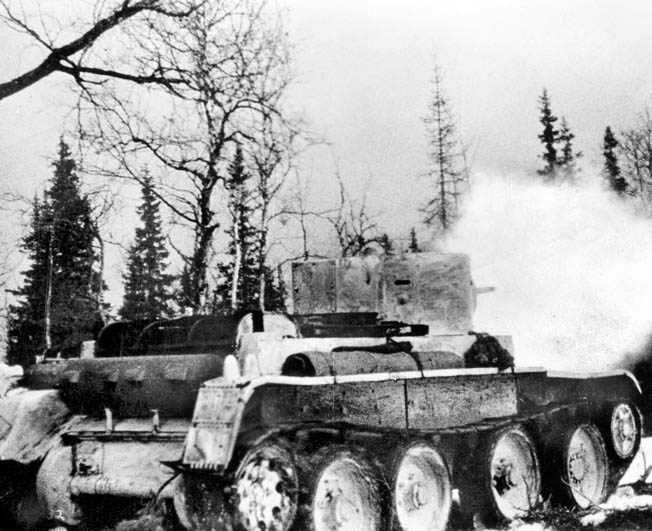
In the predawn darkness, the Soviet 75th Division hurled a battalion of infantry and nine tanks against the Finns from Ägläjärvi, going straight for the Finnish antitank platoon and ramming the first gun. Corporal Mutka, still in the battle, closed with the tank as it crunched over the Bofors gun and blew it up with a satchel charge, blocking the road for the rest of the Soviet armor.
At daylight, Mutka bore-sighted his remaining Bofors gun and hit the rear Soviet tank in the column, trapping the whole force. He worked forward with his gun and hit two more vehicles. The crews of the surviving tanks got the point. They bailed out of their vehicles, and the Finns captured them intact with their engines running. The Soviet attack was done. The Finns tried to counterattack themselves, but the Soviets held them off.
The same day, Pajari hit his own personal limit. Physically exhausted from the ordeal and personally leading attacks, he was sent to the rear by Talvela and replaced by Lt. Col. Kaarlo Viljanen, another 27th Jaeger veteran, who proved to have plenty of determination himself.
Finns and Soviets clashed on December 21, 22, and 23 with little impact. The Soviets brought up more aircraft, and the Finns brought up more antiaircraft guns, shooting down three Soviet planes on December 21.
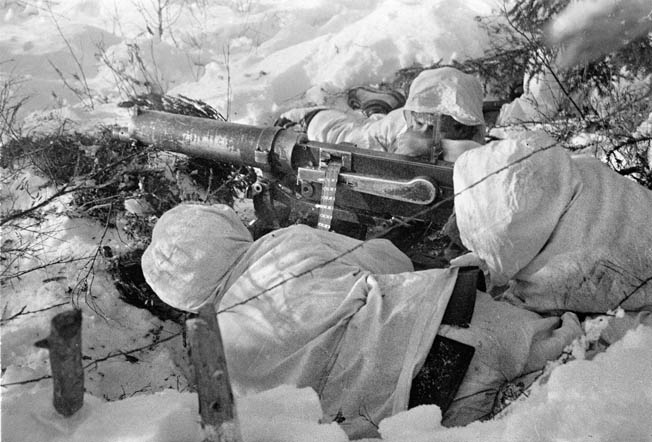
Late on the 21st, 2nd/JR-16 and two companies of ErP-9 attacked Ägläjärvi from the north, and two companies of ErP-10 and all of ErP-112 attacked from the south. In the dark, the Finns crossed the ice and closed on the village without losses against heavy but wild Soviet fire.
However, the Soviets had turned the small village into a fortress. The Soviets set up their automatic weapons for converging fire, and Finnish NCO and platoon leader casualties were again heavy—one battalion lost all three of its company commanders.
Each building was a separate strongpoint. One Finnish soldier said, “The houses were shot full of holes like sieves.” The Finns hurled grenades into the buildings, but defending wounded Soviet troops went on fighting. The Finns fought house to house and room to room with grenades and bayonets. The fighting was so close that neither side could use its mortars.
Finnish mobility eventually told the story, as one Finnish detachment cut off the village with a roadblock to the east, trapping the defenders. By noon, the 2nd Company of PPP-7 broke through into the center of the village to knock out a set of interlocking machine-gun nests. By 2 pm, the Soviets, short of ammunition and men, were in retreat. By dusk, Mannerheim called off further attacks, aware of his limited supplies of men and munitions.
After the victory, fighting did not stop in the Tolvajärvi sector. On Christmas Day, the Soviets bombed Pajari’s headquarters at Aittojoki, killing the regimental chaplain while he held Christmas services. The Finnish Air Force retaliated, shooting down four Soviet bombers.
After that, fighting quieted down in the sector to company-sized actions and ski patrols, and in late December the first Finnish-American volunteers to reach the front were deployed to that sector, making up for the heavy losses. It was a token force of about a platoon, but it was in action for the rest of the war, providing at least moral if not material support to the Finnish cause.
Panin and Belaev faced defeat on their side. The 139th Division had lost a regimental headquarters, most of its artillery, and had been thoroughly mauled. Many men, including officers, were close to mutiny. Panin and Belaev ordered the division to withdraw, something the Red Army had not done since the Russian Civil War in 1919. Doing so was a shock to the Soviets and a boost to Finnish morale.
Another casualty of the campaign was the 8th Army’s boss, Corps Commander Khabarov, who was replaced by Army Commander (Second Rank) Grigory Mikhailovich Shtern, a Stalin favorite. Ironically, he would be shot in a last-minute purge in June 1941, just before the German invasion of Russia.
The Tolvajärvi campaign was Finland’s bloodiest of the war. Talvela lost a third of his officers and NCOs and a quarter of his other ranks, a total of 630 men killed and 1,320 wounded.
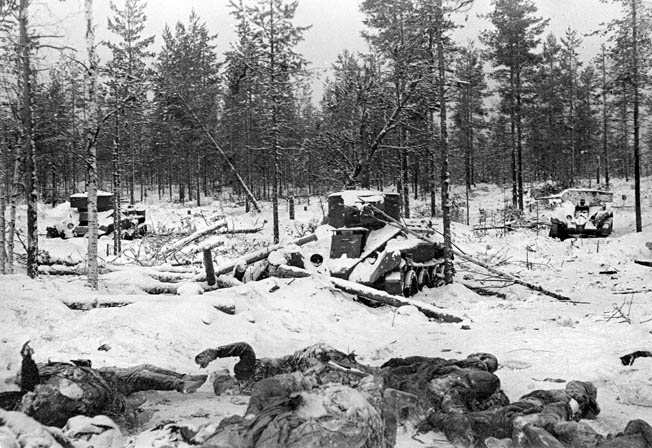
Soviet losses were more difficult to count. At least 1,000 died in the snow without being seen or counted. The Finns pulled 4,000 Soviet bodies out of the snow between Tolvajärvi and Aittojoki. Some 5,000 Soviets were wounded and almost 600 taken prisoner, many suffering frostbite due to poor winter clothing. The Soviets also lost 59 tanks and armored cars. The Finns took possession of 220 usable machine guns and light automatic weapons.
Talvela had eliminated the Soviet threat to the entire Ladoga-Karelia Front, burned up the Soviet 8th Army’s reserves, and provided his own nation with a huge morale booster after the failure on the Karelian Isthmus. The campaign showed the toughness of the individual Finnish soldier and the weakness of the average Soviet soldier. The Soviet prisoners said they did not know why they were fighting. Perhaps most significantly, the victory displayed the courage and battlefield prowess of numerous Finnish officers.
But nobody thought about this at nightfall on December 23, when the Finns reached the Aittojoki River. The riverbank was a good defensive line, the Soviet threat was decisively checked, and the Finns were exhausted. They had done enough for two weeks, and the weary Finns began digging in, breaking into ration packs. They would enjoy a special treat for Christmas, gifts from the 80,000-strong Lotta Svärd women’s organization, including civilian gifts of knitted clothing, delicacies, coffee, brandy, tobacco, and aquavit.
It was a welcome respite from the fighting against the Soviet juggernaut, and it proved all too brief. Soon enough the Red Army would return, and the war would continue until March 1940, as their overwhelming superiority in men and materiel resulted in a costly victory for the invaders.
Author David Lippman is a frequent contributor to WWII History. He also maintains a website dedicated to the daily events of World War II.
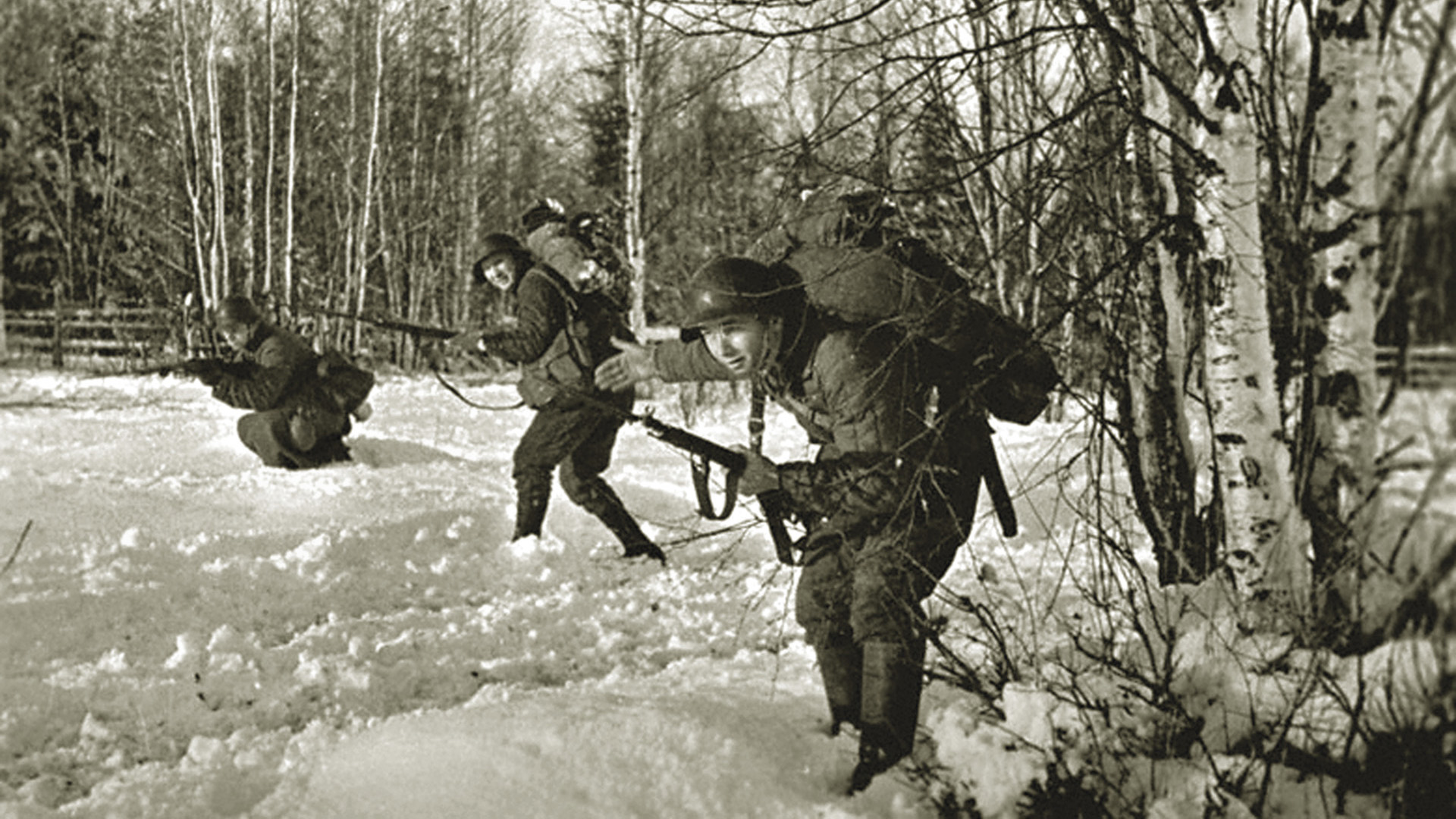
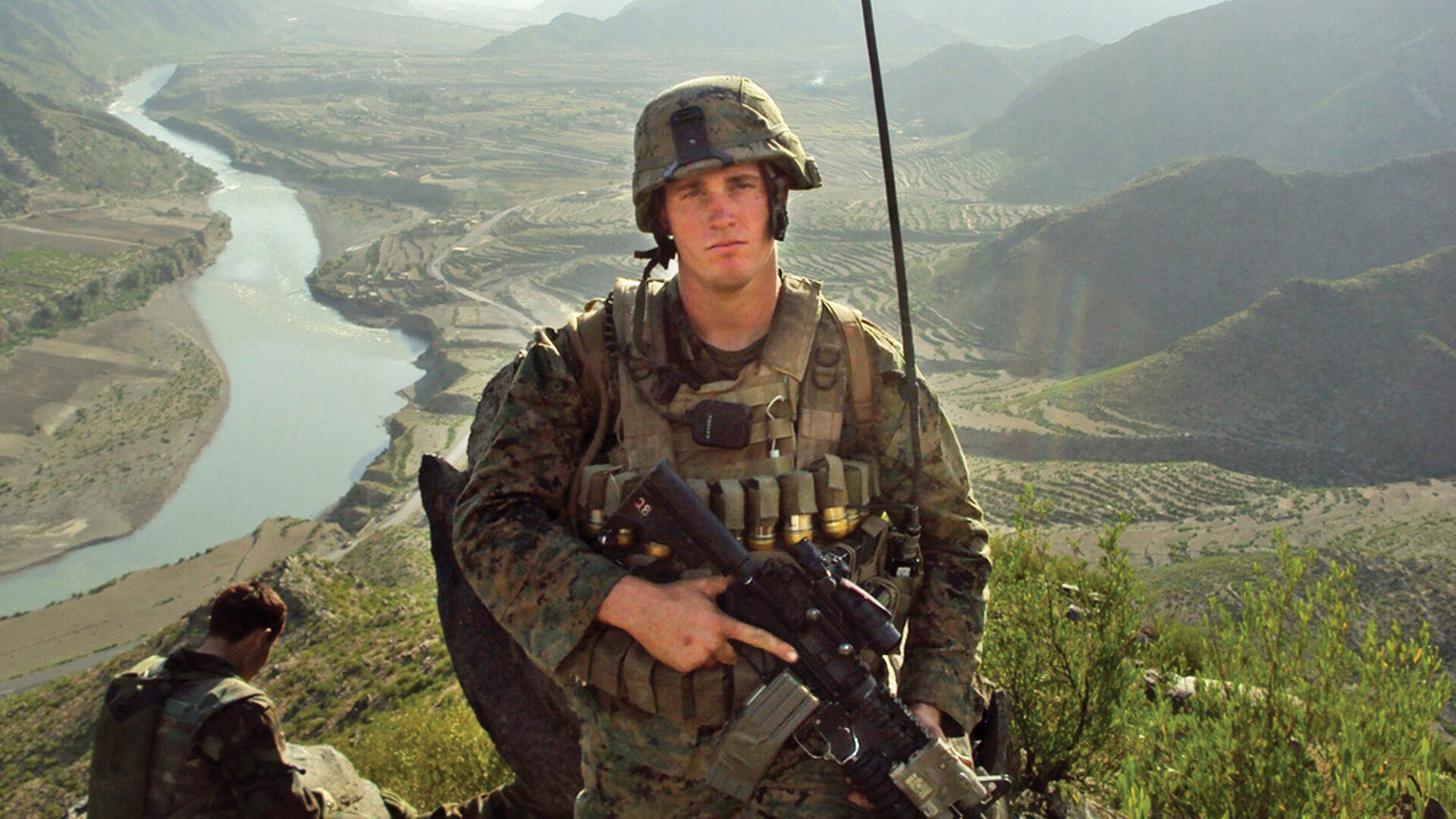
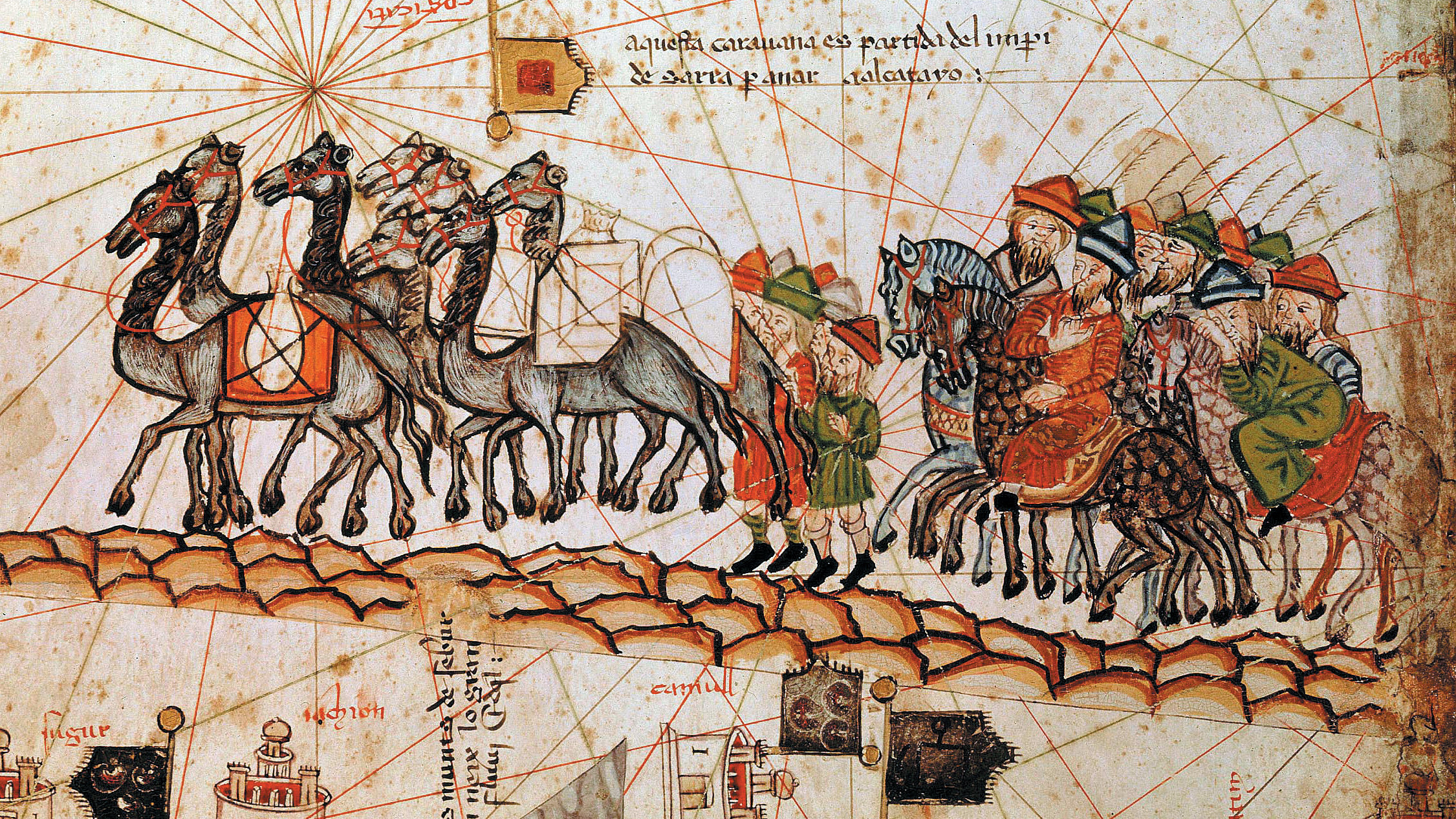
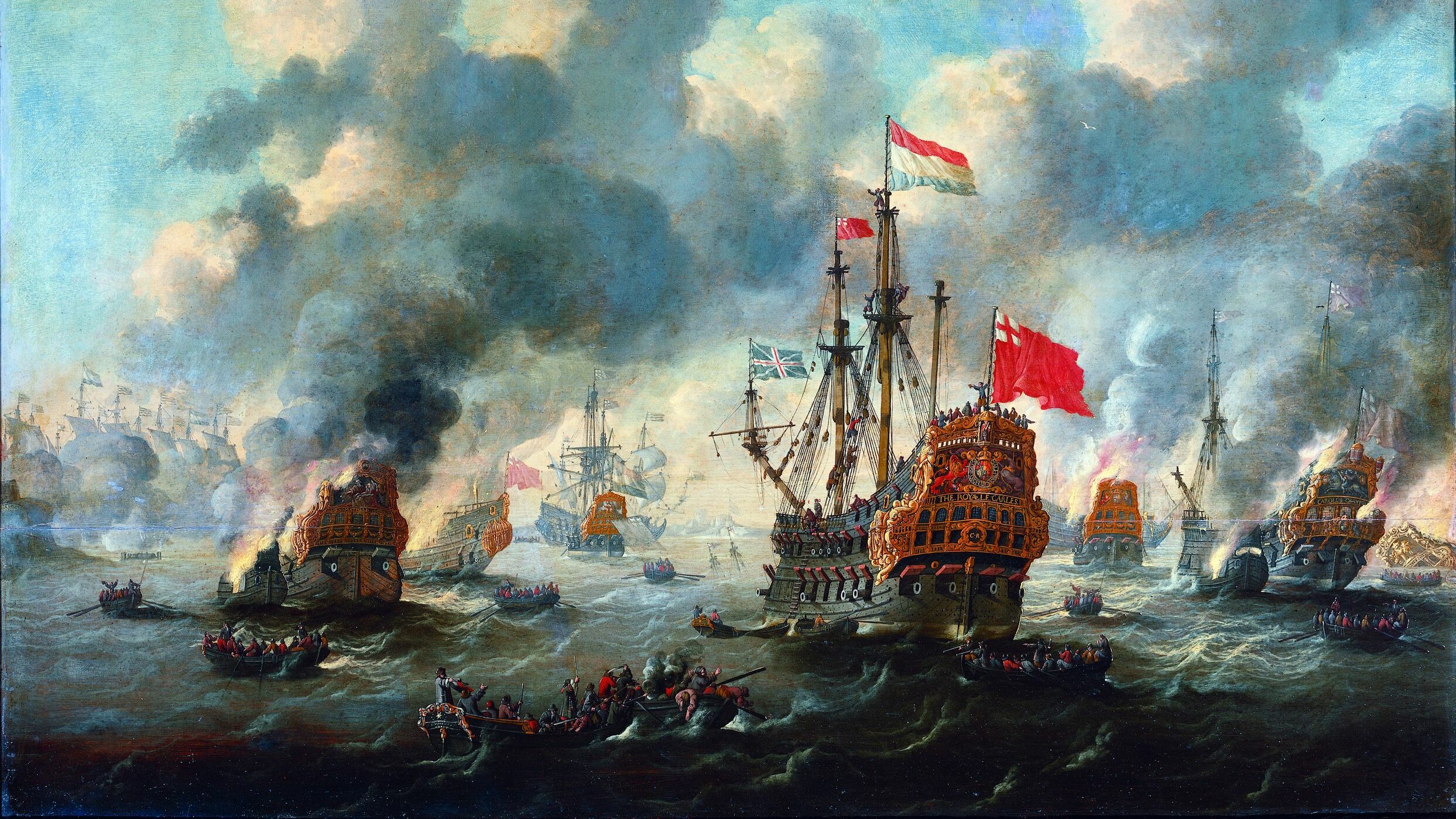

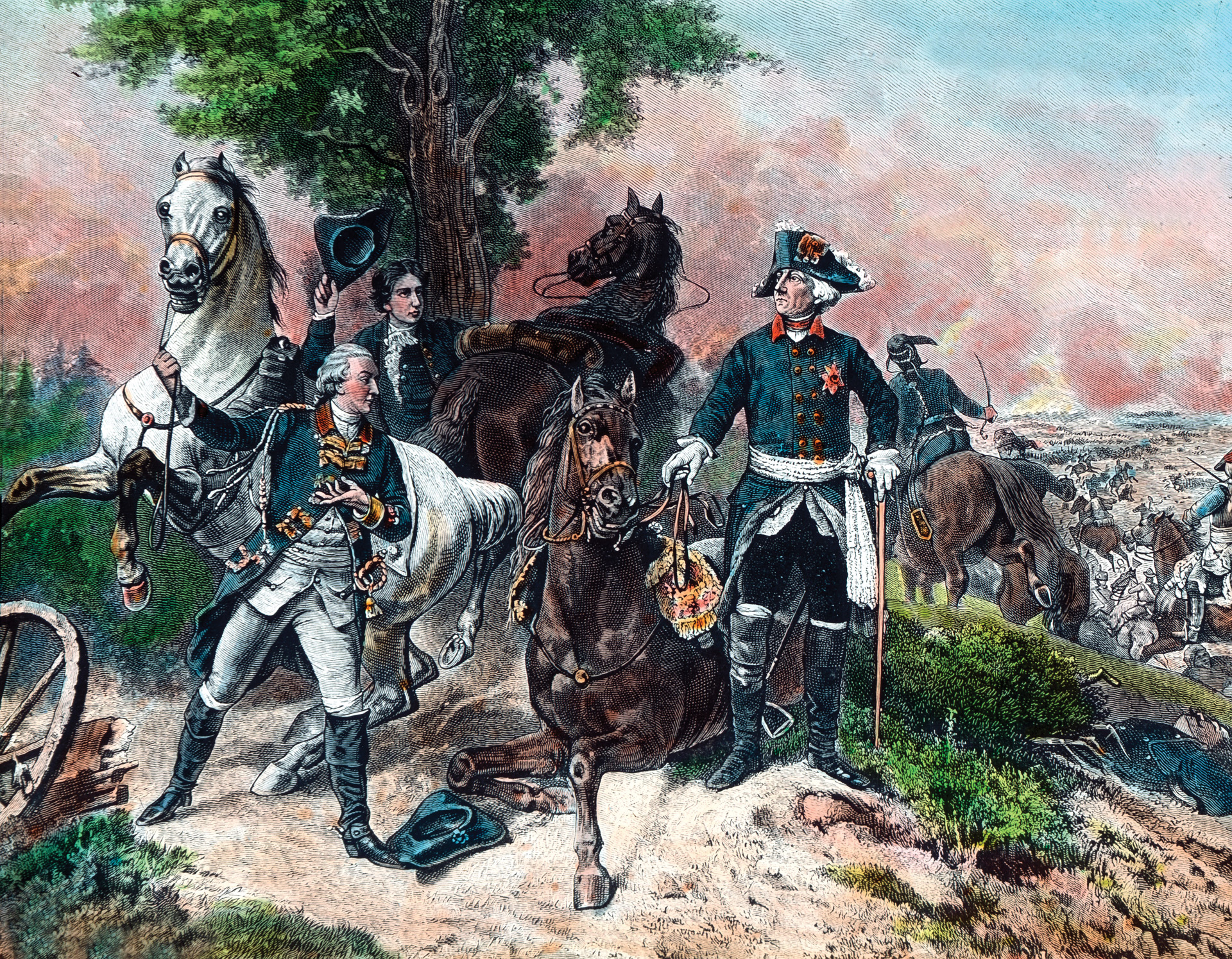
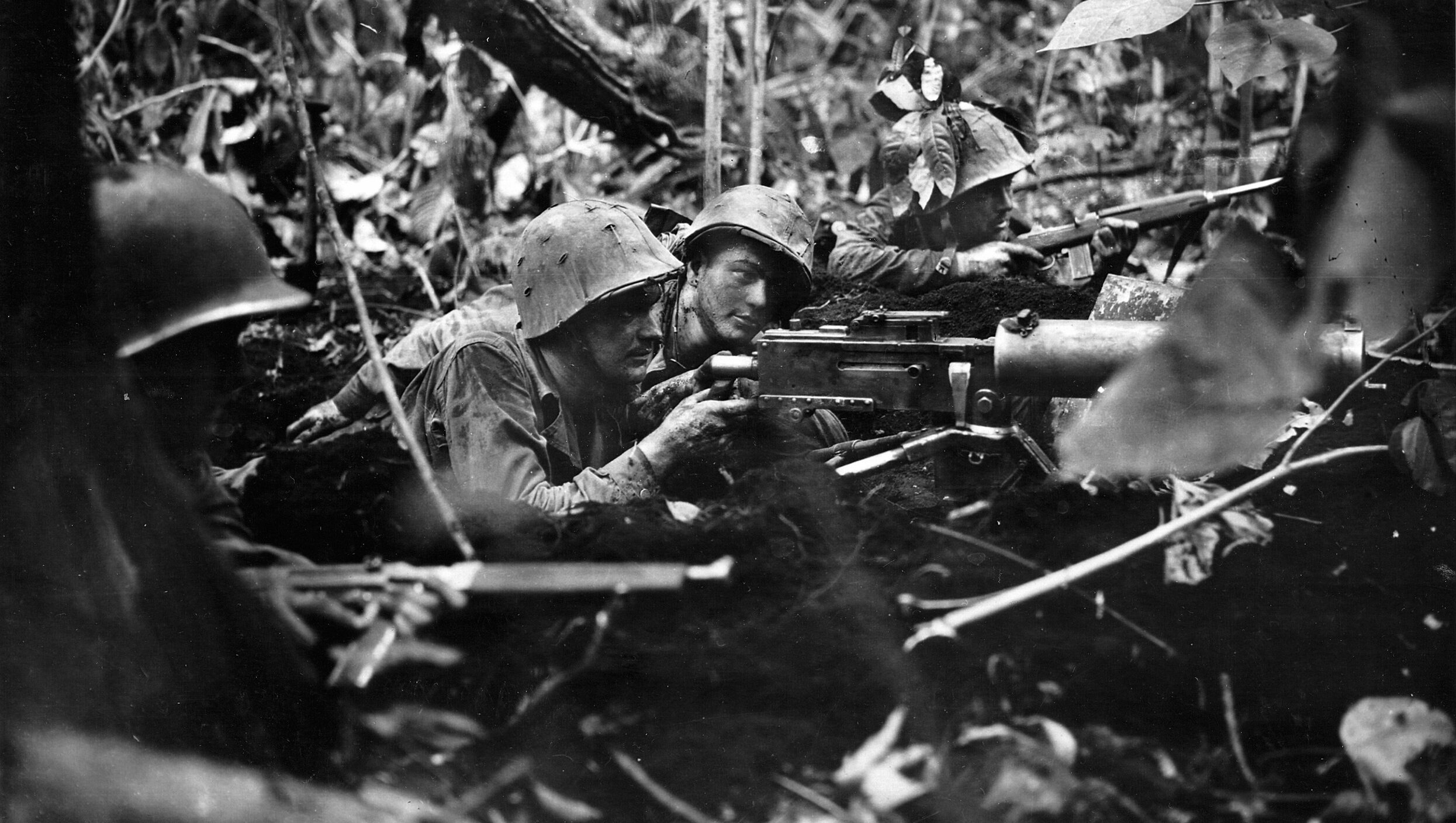
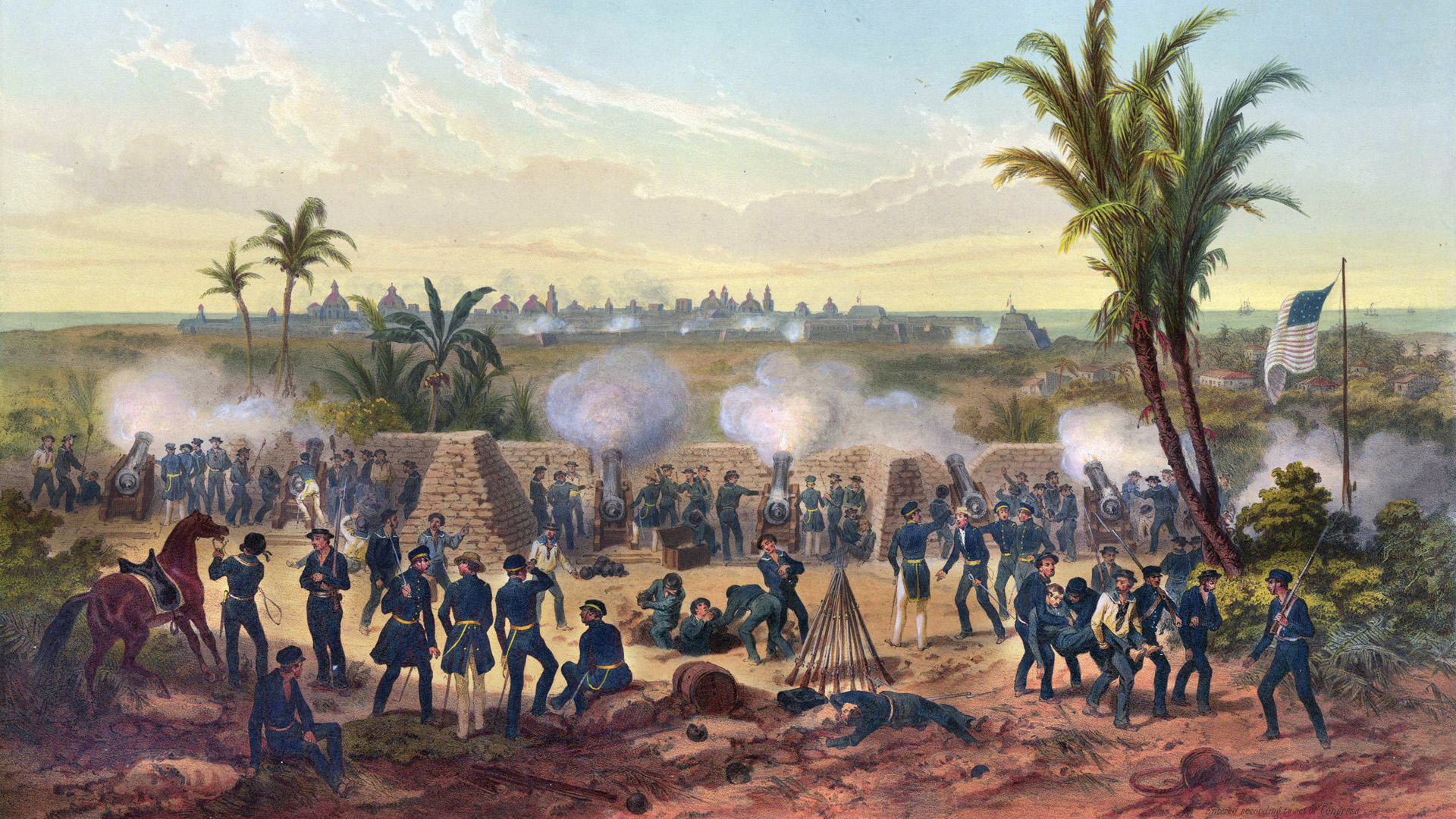
In picture of two leaders, supreme commander Mannerheim is on the RIGHT side. You recognize him from marshall collar, and he has hair. Or maybe the picture in website is mirrored from original?
Riveting stuff! Sausage war, what a story! Kudos, mr. Lippman.